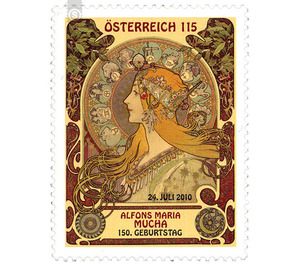150th birthday - Austria / II. Republic of Austria 2010 - 55 Euro Cent
Theme: Art & Culture
| Country | Austria / II. Republic of Austria |
| Issue Date | 2010 |
| Face Value | 55.00 |
| Edition Issued | 250,000 |
| Printing Type | offset |
| Stamp Type | Commemorative |
| Item Type | Stamp |
| Chronological Issue Number | 2220 |
| Chronological Chapter | OOS-OE2 |
| SID | 70770 |
| In 58 Wishlists | |
Alfons Maria Mucha (1860-1939) was a Czech painter, graphic artist and illustrator and is considered one of the most important representatives of Art Nouveau. For the 150th return of his birthday, the Austrian Post now congratulates with its own special stamp. The motif shows the work entitled "La Plume" (color lithograph, original size 64.5 x 48 cm). Mucha, who began his career as an autodidact, was rejected at the time by the Prague Art Academy. From 1879 to 1881 he therefore attended a Viennese school for stage decoration; In the evening he also took drawing lessons. In 1882 he received his first major contract, namely the interior design of the neo-baroque Moravian castle Emin Zámek (Emmahof) at Hrušovany nad Jevišovkou (Grusbach); As a result, Mucha executed other paintings in the family castle of the Khuen-Belasi Gandegg family near Eppan in South Tyrol. On the occasion of the World's Fair, the young artist finally moved to Paris, at that time the artistic mecca par excellence. With small assignments for various book illustrations he was able to stay afloat, and for a few weeks he had a studio together with the famous French painter Paul Gauguin. His breakthrough came from the actress Sarah Bernhardt, who in the winter of 1894 was looking for an artist to design an event poster for the play "Gismonda" because her usual contractors had failed. Mucha got the job - and so hung more or less "overnight" throughout Paris his posters. These were so coveted that almost all were "removed" by art lovers; Mucha was one of the most sought-after poster painters of the Belle Epoque. Two years later, he designed a poster for Sarah Bernhardt ("Die Kameliendame"), which is often described as one of the early highlights of the Art Nouveau graphics. During this time, he also began to draft designs for stocks and bonds - also insurance policies carry impressive Muchas unmistakable artistic signature. In 1904, now knighted by the French Legion of Honor, Mucha went to the United States for two years to teach as a lecturer at the Fine Arts Academies in New York, Philadelphia and Chicago. After the First World War Mucha returned to Czechoslovakia, where he continued to work as an artist - so he designed z. Stamps (including the first stamp of 1918 with a Hradschin motif), banknotes and medals for the still young state. Financially independent, he lived with his wife and two children in a castle north of Prague. After the invasion of German troops in 1939, Mucha was one of the first to be interned; Shortly thereafter, the artist died as a result of severe pneumonia.


